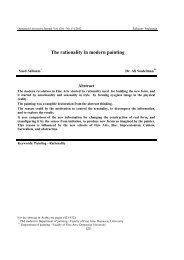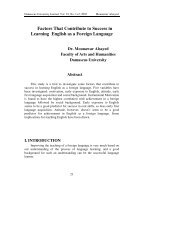<strong>Types</strong> <strong>of</strong> <strong>Obscurity</strong> <strong>in</strong> <strong>Thomas</strong> <strong>Hardy's</strong> <strong>Jude</strong> <strong>the</strong> <strong>Obscure</strong> <strong>and</strong> Maurice Blanchot's …What matters here is <strong>the</strong> priority given to <strong>the</strong> text while <strong>the</strong> role <strong>of</strong> <strong>the</strong>producer <strong>of</strong> <strong>the</strong> writer seems to be negligible or marg<strong>in</strong>al at best. IndeedBlanchot states elsewhere that creative writ<strong>in</strong>g is a sort <strong>of</strong> selfannihilation<strong>and</strong> that <strong>the</strong> writer, just like Orpheus <strong>in</strong> his cont<strong>in</strong>uousentanglement between ga<strong>in</strong><strong>in</strong>g <strong>and</strong> los<strong>in</strong>g, atta<strong>in</strong>s <strong>the</strong> aes<strong>the</strong>tic experiencewhileannihilat<strong>in</strong>g his <strong>in</strong>dividuality.The reason for all this is that <strong>the</strong>re is no correspondence between what is<strong>in</strong>side literature <strong>and</strong> what is <strong>the</strong>re <strong>in</strong> <strong>the</strong> objective reality,' <strong>the</strong> shift from aworld where everyth<strong>in</strong>g more or less has mean<strong>in</strong>g ,where <strong>the</strong>re isdarkness <strong>and</strong> light, to a realm where ,literally speak<strong>in</strong>g, noth<strong>in</strong>g yet hasmean<strong>in</strong>g ,towards which ,never<strong>the</strong>less, everyth<strong>in</strong>g that has mean<strong>in</strong>greaches back, as towards its orig<strong>in</strong>'(Ray 2).There is much to be said hereas <strong>the</strong> titles <strong>of</strong> his two <strong>in</strong>fluential prose texts, The Gaze <strong>of</strong> Orpheus <strong>and</strong>The Sirens'Song not only evoke classical echoes ,but also <strong>the</strong>y refer to<strong>the</strong> creative process <strong>and</strong> <strong>the</strong> costs it <strong>in</strong>evitably entails. If Orpheus h<strong>in</strong>geson <strong>the</strong> impossibility <strong>of</strong> achiev<strong>in</strong>g a k<strong>in</strong>d <strong>of</strong> syn<strong>the</strong>sis between creativity<strong>and</strong> matrimonial life, <strong>the</strong> story <strong>of</strong> Ulysses <strong>and</strong> his challenges <strong>of</strong> <strong>the</strong>dangers <strong>of</strong> <strong>the</strong> Sirens illum<strong>in</strong>ate <strong>the</strong>se pa<strong>in</strong>stak<strong>in</strong>g tasks. Unable to resist<strong>the</strong> <strong>in</strong>fatuat<strong>in</strong>g but destructive songs <strong>of</strong> <strong>the</strong>se Sirens, Ulysses made hissailors lash him to <strong>the</strong> mast while <strong>the</strong>y, ears stuffed with wax, piloted <strong>the</strong>boat to safety. Thus he could cheat <strong>the</strong> Sirens, hear<strong>in</strong>g <strong>the</strong>ir song without<strong>in</strong>curr<strong>in</strong>g destruction. Gabriel Josipovici has <strong>the</strong> follow<strong>in</strong>g to say about<strong>the</strong> connotations <strong>of</strong> this primordial scene,Ulysses was cunn<strong>in</strong>g <strong>and</strong> resourceful, but did he <strong>in</strong> fact triumphover <strong>the</strong> Sirens? Did he from <strong>the</strong> safety <strong>of</strong> his ship, really hear<strong>the</strong> true song? Or is that reserved for those who go to <strong>the</strong> Sirensopenly? One could also say, from ano<strong>the</strong>r perspective, thatUlysses was not <strong>in</strong> fact saved, s<strong>in</strong>ce after hear<strong>in</strong>g <strong>the</strong>m he wascondemned to repeat <strong>the</strong>ir song for ever <strong>in</strong> <strong>the</strong> words <strong>of</strong> <strong>the</strong>Odyssey?(Blanchot,1982, 8)This idea <strong>of</strong> <strong>the</strong> <strong>in</strong>determ<strong>in</strong>acy <strong>and</strong> endlessness <strong>of</strong> <strong>the</strong> mean<strong>in</strong>g whichkeeps tak<strong>in</strong>g different forms <strong>and</strong> manifestations will be <strong>the</strong> favorite fieldfor critics like Derrida <strong>and</strong> his renowned concept <strong>of</strong> 'differance', <strong>the</strong>130
Damascus University Journal, Vol.28 No.1, 2012Sabbar S. Sultanendless postpon<strong>in</strong>g <strong>of</strong> <strong>the</strong> literary mean<strong>in</strong>g <strong>and</strong> concealment as a result <strong>of</strong><strong>the</strong> writer's failure to comm<strong>and</strong> his own medium or <strong>the</strong> slippery side <strong>of</strong><strong>the</strong> language itself. Also Bar<strong>the</strong>s's famous article 'Death <strong>of</strong> <strong>the</strong> Author'(1967) <strong>and</strong> Foucault's 'What is an Author' (1970)have <strong>the</strong>ir own start<strong>in</strong>gpo<strong>in</strong>t <strong>in</strong> Blanchot's cogent arguments stated <strong>in</strong> The Space <strong>of</strong> Literature<strong>and</strong> many o<strong>the</strong>r books. As De Man puts it, Blanchot' wants us to take <strong>the</strong>work for what it is <strong>and</strong> thus to rid it <strong>of</strong> <strong>the</strong> presence <strong>of</strong> <strong>the</strong> author'(de Man64).Thanks to Blanchot's critical discussions, <strong>the</strong> idea <strong>of</strong> '<strong>the</strong> death <strong>of</strong>literature' takes its f<strong>in</strong>al <strong>and</strong> conclusive shape. The manifestations <strong>of</strong> thisepistemological <strong>and</strong> <strong>in</strong>tellectual malaise are many. Among <strong>the</strong>se is <strong>the</strong>realization that <strong>the</strong> reader gradually replaces <strong>the</strong> author <strong>in</strong> determ<strong>in</strong><strong>in</strong>g <strong>the</strong>f<strong>in</strong>al mean<strong>in</strong>g <strong>of</strong> <strong>the</strong> literary text <strong>and</strong> <strong>the</strong> critic competes <strong>and</strong> defeats <strong>the</strong>writer <strong>in</strong> <strong>the</strong> literary process (Kernan 2). Blanchot anticipated <strong>the</strong> callsfor <strong>the</strong> vigorous role <strong>of</strong> <strong>the</strong> reader when he mentioned that 'It is said thatevery writer writes <strong>in</strong> <strong>the</strong> presence <strong>of</strong> a certa<strong>in</strong> reader' (Blanchot,1995,359).The only defense or justification for such a lengthy <strong>in</strong>troduction is<strong>the</strong> fact that Blanchot is a puzzl<strong>in</strong>g figure <strong>in</strong> <strong>the</strong> creative <strong>and</strong> critical scenenot only for people from different languages <strong>and</strong> cultures but also for hisown European community. Leav<strong>in</strong>g his critique aside, we f<strong>in</strong>d that hisfiction never veers from this pivot. Indeed his fiction, represented by his<strong>Thomas</strong> <strong>the</strong> <strong>Obscure</strong> belongs to <strong>the</strong> self-referential type <strong>in</strong>augurated bySterne's Tristram Sh<strong>and</strong>y (1760-7) <strong>and</strong> Joyce's A Portrait <strong>of</strong> <strong>the</strong> Artist asa Young Man( 1914). It seeks to <strong>in</strong>vestigate its own tools <strong>and</strong> rem<strong>in</strong>ds <strong>the</strong>reader <strong>of</strong> <strong>the</strong> fictionality <strong>of</strong> its text. Moreover <strong>the</strong>re is a successfulwedd<strong>in</strong>g between <strong>the</strong> creative <strong>and</strong> <strong>the</strong> critical, or if you wish, <strong>the</strong> creativeis made to serve <strong>the</strong> critical <strong>and</strong> exemplify it, concretize it, as it were. Hisfictional texts pursue one <strong>in</strong>variable l<strong>in</strong>e: <strong>the</strong> keen <strong>in</strong>terest to show how'<strong>the</strong> formal features <strong>of</strong> a text, matters <strong>of</strong> style, can be <strong>in</strong>dices to large<strong>in</strong>tellectual <strong>and</strong> cultural matters'(Strier 211).The l<strong>in</strong>guistic levels <strong>of</strong> hisfiction can not be isolated from his <strong>the</strong>matic ones. In one <strong>of</strong> <strong>the</strong> anecdotes<strong>of</strong> <strong>Thomas</strong>, <strong>the</strong> common notion <strong>of</strong> read<strong>in</strong>g virtually <strong>in</strong>verts: it is <strong>the</strong> textthat reads <strong>the</strong> reader,Under <strong>the</strong> pressure <strong>of</strong> a lim<strong>in</strong>ality that b<strong>in</strong>ds reader to what hereads ,<strong>Thomas</strong>'s read<strong>in</strong>g mutates until it beg<strong>in</strong>s to manifest <strong>the</strong>131
- Page 1 and 2: Damascus University Journal, Vol.28
- Page 3 and 4: Damascus University Journal, Vol.28
- Page 5 and 6: Damascus University Journal, Vol.28
- Page 7 and 8: Damascus University Journal, Vol.28
- Page 9 and 10: Damascus University Journal, Vol.28
- Page 11 and 12: Damascus University Journal, Vol.28
- Page 13 and 14: Damascus University Journal, Vol.28
- Page 15 and 16: Damascus University Journal, Vol.28
- Page 17: Damascus University Journal, Vol.28
- Page 21 and 22: Damascus University Journal, Vol.28
- Page 23 and 24: Damascus University Journal, Vol.28
- Page 25 and 26: Damascus University Journal, Vol.28
- Page 27 and 28: Damascus University Journal, Vol.28
- Page 29 and 30: Damascus University Journal, Vol.28
- Page 31 and 32: Damascus University Journal, Vol.28
- Page 33 and 34: Damascus University Journal, Vol.28
- Page 35 and 36: Damascus University Journal, Vol.28
- Page 37 and 38: Damascus University Journal, Vol.28
















